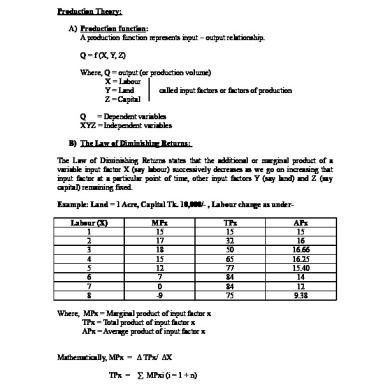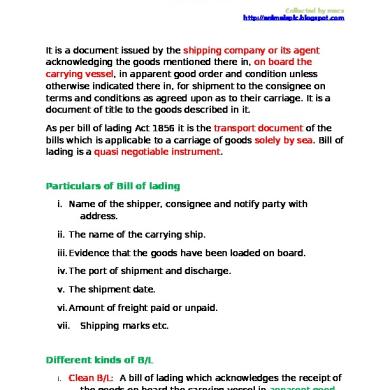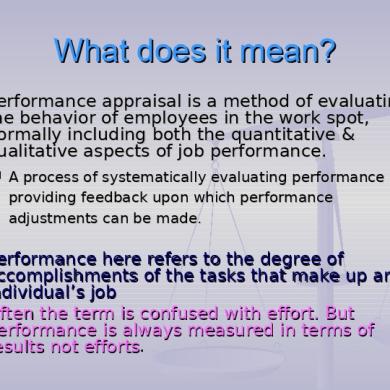Corporate And Division Level Strategic Planning
This document was uploaded by user and they confirmed that they have the permission to share it. If you are author or own the copyright of this book, please report to us by using this DMCA report form. Report DMCA
Overview
Download & View Corporate And Division Level Strategic Planning as PDF for free.
More details
- Words: 1,099
- Pages: 7
Marketing Class 02- Corporate & Division level Strategic Planning, Business unit strategic planning Corporate & division strategic planning: Define strategic planning: Strategic planning can be defined as the process of determining the basic long term objectives of an enterprise and the adoption of courses of action and allocation of resources necessary to achieve these objectives. i)
Defining corporate mission
ii)
Establishing Strategic Business Units (SBU)
iii)
Assigning resource to each SBU
iv)
Planning new business and downsizing older business
A) Defining corporate mission: Defining corporate mission helps to create a sense of direction and opportunity for the organization. Example: Corporate mission of prime finance: Be a leading, efficient customer oriented financial service provider in its selected market. Good corporate mission statements focus on three characteristics: i)
Limited number of goals/objectives
ii)
Honor corporate policies and values
iii)
Define major competitive scopes in its selected market( e.g. industry , product & application, competence, market segment, vertical, geographical scopes)
B) Establishing SBU i) SBU must be planned separately from the rest of the company ii) SBU has its own set of competitors iii) SBU has a manager who is responsible for strategic planning Example:
Page 1 of 7
Beximco is now managing 22 business units at a time such as Beximco Pharmaceuticals, Textiles, Denim etc. Each of these units can be classified as SBU.
Page 2 of 7
Product and market definition of business: Product Definition: Defining business in terms of product. Market Definition: Defining business in terms of customer satisfying process. Examples: Products definition
market definition
i)
Xerox office productivity
We make copying equipment
We help improve
ii)
Standard oil
We sell gasoline
We supply energy
iii)
movie co.
iv)
Garments Ind.
We make movie We stitch clothes
We sell entertainment We sell fashion
C) Assigning resources to each SBU When a company has a number of products in the market, not all of them are contributing equally, not all of them have equal opportunity for growth. Each of them has to be treated differently and budget allocation make separately. Examples: Boston consulting group approach i)
Question marks- operate in high growth rate where there is already a market leader. Company has to pour more investment to stay competitive.
ii)
Stars- a star is a market leader in high growth market-may not give sufficient revenue or profit
iii)
Cash cows-when growth rate falls than 10% the stars becomes a cash cow provided it still has a very high market share and contributed significantly to the profitability of the company. Growth rate has slowed because the sector growth has slowed.
iv)
Dogs-here the objective is to sell or liquidate the business because resource can be better utilized elsewhere.
D) Planning new business and downsizing older business: Every company has plans for growth. When desired sales targets are not met, strategic planning needs to be re-examined. Growth is possible in three ways:a) Intensive Growth: Growth within the company’s current Business.
Page 3 of 7
i)
Market Penetration Strategy, (for current market, current product) Trying to increase market share in the current market (reducing price, offering free gift with the product) Example: RC cola has reduced the price of the can from TK 15 to TK 12.
ii)
Product Development Strategy, (new product for current market) Audio cassette producer which is currently producing 60 min tape started to producing 90 min tape. Example: The introduction of prepaid card by the Grameen Phone. Lever Brothers has introduced mini soap and mini pack shampoo.
iii)
Market Development Strategy, ( for new market, current product) Example: Virgin has introduced diet virgin for older people Igloo has introduced Diet ice cream for diabetic patient
Ansoff’s grid Current product Current market New market
1. Market penetration 3. Market development
new product 2. Product development 4. (Diversification)
b) Integrative growth: Growth opportunities in the businesses that are related to the company’s current businesses. i)
Backward integration-Acquiring one or more suppliers to gain control Example: Levis Strauss and the company acquire Milliken and company for fabric supplier then it will be backward integration.
Page 4 of 7
ii)
Forward integration-Acquiring one or more whole sellers if they are more profitable Example: Levis Strauss and the company acquire its major retailers Sears then it will be a forward integration.
iii)
Horizontal integration-Acquiring one or more competitors Example: Standard and Chartered merged with Greenlays bank to acquire more market share.
c) Diversification growth: Opportunities in the businesses that are unrelated to the company’s current businesses. i)
Concentric diversification-Developing new product that has technological and marketing synergies with current product. Example: if an audio cassette tape manufacturer starts producing computer tape then it will be termed as concentric diversification strategy.
ii)
Horizontal diversification-Developing new product that might appeal current customers but not related with current business. Example: if the audio cassette tapes producer start producing cassette holding trays for the current customers then it will be a horizontal diversification strategy.
iii)
Conglomerate-Developing new business that has no relation with company’s technology, products or markets Example: a leather goods manufacturer starts manufacturing electronics goods then it will be the conglomerate diversification strategy.
Business unit strategic planning: 1) Define business mission: Particular mission defined by a business unit within the broader corporate mission. Example: The mission of a particular TV studio lighting equipment company may be to target the major TV studios and be their number one choice by offering the most developed and reliable studio lighting arrangements.
SWOT External: Opportunity & Threat Internal: Strength & Weakness Page 5 of 7
2) Goal formulation: Characteristics of specified goalsi.
They are specific objectives with respect to magnitude and time
ii.
They facilitate management planning, implementation of plans, and control
iii.
They help the company operate by Management by Objectives (MBO) The four criteria objectives must meet for an effective MBO system: •
Objectives must be arranged hierarchically
•
Objectives must be stated quantitatively
•
Objectives should be realistic
•
Objectives should be consistent
3) Strategic formulation-These are specific means to achieve objectives Three types of strategies: Overall Cost Leadership Differentiation Focus Strategic Alliances: Being in co-operation with strategic partners Example: Proton World International, the joint venture of American Express and Visa International 4) Programme formulation-Each program should be analyzed by the activity Based cost accounting to find out whether it will produce sufficient result and offset the costs 5) Implementation-Carrying out the programs to achieve the expected objectives 6) Feedback & control-The process of tracking the results, monitoring developments in the environments, and taking corrective actions when faced with major changes in the marketplace. End
Page 6 of 7
Page 7 of 7
Defining corporate mission
ii)
Establishing Strategic Business Units (SBU)
iii)
Assigning resource to each SBU
iv)
Planning new business and downsizing older business
A) Defining corporate mission: Defining corporate mission helps to create a sense of direction and opportunity for the organization. Example: Corporate mission of prime finance: Be a leading, efficient customer oriented financial service provider in its selected market. Good corporate mission statements focus on three characteristics: i)
Limited number of goals/objectives
ii)
Honor corporate policies and values
iii)
Define major competitive scopes in its selected market( e.g. industry , product & application, competence, market segment, vertical, geographical scopes)
B) Establishing SBU i) SBU must be planned separately from the rest of the company ii) SBU has its own set of competitors iii) SBU has a manager who is responsible for strategic planning Example:
Page 1 of 7
Beximco is now managing 22 business units at a time such as Beximco Pharmaceuticals, Textiles, Denim etc. Each of these units can be classified as SBU.
Page 2 of 7
Product and market definition of business: Product Definition: Defining business in terms of product. Market Definition: Defining business in terms of customer satisfying process. Examples: Products definition
market definition
i)
Xerox office productivity
We make copying equipment
We help improve
ii)
Standard oil
We sell gasoline
We supply energy
iii)
movie co.
iv)
Garments Ind.
We make movie We stitch clothes
We sell entertainment We sell fashion
C) Assigning resources to each SBU When a company has a number of products in the market, not all of them are contributing equally, not all of them have equal opportunity for growth. Each of them has to be treated differently and budget allocation make separately. Examples: Boston consulting group approach i)
Question marks- operate in high growth rate where there is already a market leader. Company has to pour more investment to stay competitive.
ii)
Stars- a star is a market leader in high growth market-may not give sufficient revenue or profit
iii)
Cash cows-when growth rate falls than 10% the stars becomes a cash cow provided it still has a very high market share and contributed significantly to the profitability of the company. Growth rate has slowed because the sector growth has slowed.
iv)
Dogs-here the objective is to sell or liquidate the business because resource can be better utilized elsewhere.
D) Planning new business and downsizing older business: Every company has plans for growth. When desired sales targets are not met, strategic planning needs to be re-examined. Growth is possible in three ways:a) Intensive Growth: Growth within the company’s current Business.
Page 3 of 7
i)
Market Penetration Strategy, (for current market, current product) Trying to increase market share in the current market (reducing price, offering free gift with the product) Example: RC cola has reduced the price of the can from TK 15 to TK 12.
ii)
Product Development Strategy, (new product for current market) Audio cassette producer which is currently producing 60 min tape started to producing 90 min tape. Example: The introduction of prepaid card by the Grameen Phone. Lever Brothers has introduced mini soap and mini pack shampoo.
iii)
Market Development Strategy, ( for new market, current product) Example: Virgin has introduced diet virgin for older people Igloo has introduced Diet ice cream for diabetic patient
Ansoff’s grid Current product Current market New market
1. Market penetration 3. Market development
new product 2. Product development 4. (Diversification)
b) Integrative growth: Growth opportunities in the businesses that are related to the company’s current businesses. i)
Backward integration-Acquiring one or more suppliers to gain control Example: Levis Strauss and the company acquire Milliken and company for fabric supplier then it will be backward integration.
Page 4 of 7
ii)
Forward integration-Acquiring one or more whole sellers if they are more profitable Example: Levis Strauss and the company acquire its major retailers Sears then it will be a forward integration.
iii)
Horizontal integration-Acquiring one or more competitors Example: Standard and Chartered merged with Greenlays bank to acquire more market share.
c) Diversification growth: Opportunities in the businesses that are unrelated to the company’s current businesses. i)
Concentric diversification-Developing new product that has technological and marketing synergies with current product. Example: if an audio cassette tape manufacturer starts producing computer tape then it will be termed as concentric diversification strategy.
ii)
Horizontal diversification-Developing new product that might appeal current customers but not related with current business. Example: if the audio cassette tapes producer start producing cassette holding trays for the current customers then it will be a horizontal diversification strategy.
iii)
Conglomerate-Developing new business that has no relation with company’s technology, products or markets Example: a leather goods manufacturer starts manufacturing electronics goods then it will be the conglomerate diversification strategy.
Business unit strategic planning: 1) Define business mission: Particular mission defined by a business unit within the broader corporate mission. Example: The mission of a particular TV studio lighting equipment company may be to target the major TV studios and be their number one choice by offering the most developed and reliable studio lighting arrangements.
SWOT External: Opportunity & Threat Internal: Strength & Weakness Page 5 of 7
2) Goal formulation: Characteristics of specified goalsi.
They are specific objectives with respect to magnitude and time
ii.
They facilitate management planning, implementation of plans, and control
iii.
They help the company operate by Management by Objectives (MBO) The four criteria objectives must meet for an effective MBO system: •
Objectives must be arranged hierarchically
•
Objectives must be stated quantitatively
•
Objectives should be realistic
•
Objectives should be consistent
3) Strategic formulation-These are specific means to achieve objectives Three types of strategies: Overall Cost Leadership Differentiation Focus Strategic Alliances: Being in co-operation with strategic partners Example: Proton World International, the joint venture of American Express and Visa International 4) Programme formulation-Each program should be analyzed by the activity Based cost accounting to find out whether it will produce sufficient result and offset the costs 5) Implementation-Carrying out the programs to achieve the expected objectives 6) Feedback & control-The process of tracking the results, monitoring developments in the environments, and taking corrective actions when faced with major changes in the marketplace. End
Page 6 of 7
Page 7 of 7
Related Documents

Strategic Management And Planning
May 2020 15
Strategic Planning
May 2020 26
Strategic Planning
November 2019 35
Strategic Planning
July 2020 17More Documents from "lovable tania"

Production Theory
May 2020 21
Islami Song
June 2020 20
Bill Of Lading
July 2020 19
Incentives For Exporters
July 2020 27
Managing Marteing Channels
May 2020 0

